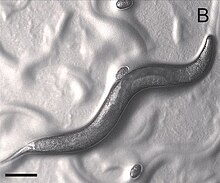P. pacificus
| Pristionchus pacificus | |
|---|---|
 |
|
| Scientific classification | |
| Kingdom: | Animalia |
| Phylum: | Nematoda |
| Class: | Chromadorea |
| Order: | Rhabditida |
| Family: | Diplogastridae |
| Genus: | Pristionchus |
| Species: |
Pristionchus pacificus Sommer, Carta, Kim & Sternberg, 1996 |
Pristionchus pacificus is a species of free-living nematodes (roundworms) in the family Diplogastridae. The species has been established as a satellite model organism to Caenorhabditis elegans, with which it shared a common ancestor 200-300 million years ago. The genome of P. pacificus has been fully sequenced, which in combination with other tools for genetic analysis make this species a tractable model in the laboratory, especially for studies of developmental biology.
Like other species of Pristionchus, but unlike C. elegans and most other free-living nematodes, P. pacificus has a polyphenism in its mouthparts that allows the nematodes to specialize on different food sources. The polyphenism has two forms, one of which (the "stenostomatous" form) is specialized for feeding on bacteria. An alternative ("eurystomatous") form, which responds to deprivation of bacterial food and to crowding by other nematodes, is equipped with two large teeth, enabling predation on other nematodes. These alternative feeding types, which allow the nematodes to respond rapidly to environmental conditions, are specified by a hormonal and genetic cascade during larval development.
...
Wikipedia
